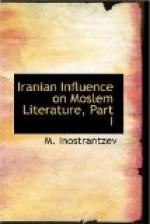Another dynasty was the mountain rulers of Qaren, which is named after its founder. The first Qaren was the son of Sokhra, the brother of Zarmihr. These princes were also styled Ispehbeds. A descendant of Qaren was Vindad-Hormizd, who in conjunction with Shervin I of the house of Bavend, and with the Badusepan, Shahriyar I, conquered the Arabs in 783, but subsequently surrendered himself to Hadi and went to Baghdad till the latter became Khalif in 785. There is some confusion in the chronology of this dynasty also. A few rulers appear to be wanting because between the beginning of the dynasty in 565 to its close in 839 the average reign of the six princes would come to 45 or 46 years. Maziyar, son of Qaren, and grandson of Vindad-Hurmizd was at first defeated by Shahryar the son of Shervin of the Bavend dynasty and took refuge with the Khalif Mamun in 816-17, and returned after the victory over Musa Ibn Hafs in 825 but was himself worsened by the Arabs in 839 and executed. Thereupon Tabaristan came into the power of the Tahirides, the nominal governors of the Khalif in Khorasan. Our authorities are Beladhori 134, 14; Masudi 7, 137; Kitab ol Oyun 399, 6; Yaqut 3, 284, 4. 506, 10; Abulfida 2, 212, 2.
The Bavend dynasty is a continuation of the Masmughans. Their original ancestor Bav who is characterised as son of Shahpur, son of Kayos, received from Khusraw II the governorship of Istakhr, Adharbaijan and Tabaristan, but retired himself into a fire-temple in the time of queen Azarmidukht. When the Arabs in 655 had advanced to the vicinity of Amul, the Mazenderanis invited him to lead them and he was the founder of the Bavend dynasty called after him. Now Bav was killed by Valash in 679, who did not belong to the dynasty and it was only 8 years later on that the son of Bav, Suhrab, more correctly Surkhab, came to the throne. With the last potentate of this first line of the Bavends was united by marriage the house of Ziyar which produced two celebrated princes of Gurgan, Vashmgir and Qabus. The other line, the “mountain kings” proper, sprang from a son of the last prince of the first line and was extinguished with the murder of Rustum by Sayed Husain in 1210. A third offshoot originating from a collateral branch of the second enjoyed princely power from 1237-1349.
The Arabs had their governors in Tabaristan who in the first period minted coins with Sasanian impress and with Pahlavi legends; they were, however, from time to time expelled by the people. These coins struck by the Arabs after the model of the Pahlavi mintage were first deciphered by Olshausen. Ibn Khaldun is compelled to admit that “the Arabs are of all the people the least capable to govern a country.”
[Translated from Justi’s contribution to Grunddrisder der iranischen Philologie. Vol. II, p. 547 seq.—G.K.N.]
To the above concise sketch of the history of Tabaristan for the period which concerns us, which I have translated from Justi, one of the most sympathetic writers on Iran, a few paras may be added from the fascinating history of Ibn-Isfandiyar which professor Browne has made accessible to us.




